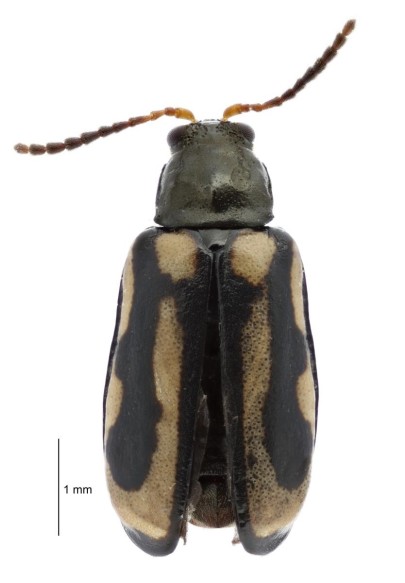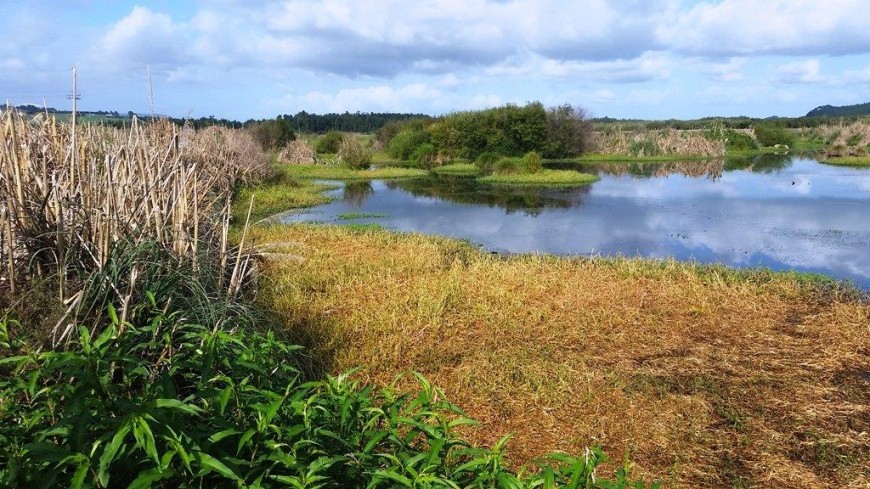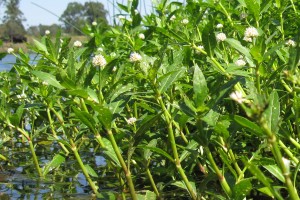Alligator weed beetle
History in New Zealand
Alligator weed beetles are native to South America, and they were first imported from Australia by the DSIR in 1981. The beetles were mass-reared and released throughout the range of alligator weed in northern New Zealand in the early 1980s. Alligator weed beetles are now established widely throughout Auckland and Northland, and at least one site in the Waikato. A similar beetle (Disonycha argentinensis), believed to be more suited to attacking terrestrial infestations, was also released in the early 1980s but failed to establish.
How would I find/recognise it and what is its lifecycle?
You are unlikely to see the adult beetles during the colder months of the year when they hide away down low in plants or soil. Look for the adults during summer and autumn when they will be out feeding on the leaves. You will easily recognise them by their striking yellow-and- black colouration. Adult beetles are about 5.5-7.0 mm long and females tend to be larger than males.

Image: alligator weed beetle (Agasicles hygrophila).
Image: alligator weed beetle (Agasicles hygrophila).
If you turn over the leaves near the top of alligator weed plants, then you might see their oval-shaped eggs, which are laid in batches. The eggs start off whitish but quickly become pale yellowish-orange in colour. Females lay on average about 400 eggs each, but some may lay as many as 1800.
Image: alligator weed beetle eggs.
Image: alligator weed beetle eggs.
The eggs usually hatch within a week. The newly hatched black caterpillar-like larvae are initially gregarious but gradually migrate away to feed on adjacent plant material. At high temperatures, the larvae can complete development in just over a week. Just before pupation, the larvae stop feeding, move down the stems and burrow inside, while still remaining above the waterline. They plug the hole behind them (as protection against water and predators) and pupate. The cream-coloured pupae eventually turn brown and new adults emerge within a week. The new adults chew their way out of the stem, usually just above the entrance hole, and begin to feed on leaves. New adults can live for up to 6 months. Up to four generations may be produced each year.
Image: alligator weed beetle larva.
You are unlikely to confuse the alligator weed beetle with the other biological control agent commonly seen on alligator weed, which is a moth (see Alligator weed moth).
How does it damage alligator weed?
Both the adults and larvae feed on the aerial parts of the plant, especially around the edges of the weed mats. Young larvae tend to feed on the undersides of the leaves and the upper epidermis remains intact. Early feeding damage resembles pin pricks in the leaves but later these holes become larger and more irregular in shape. Older larvae and adults feed on both sides of leaves and stems and may destroy the plant down to water level.
Image: alligator weed beetle damage.
Image: alligator weed beetle feeding damage.
Will it attack other plants?
The beetle may occasionally cause minor damage to Alternanthera nahui and A. denticulata.
How effective is it?
Large populations of beetles can cause considerable damage to alligator weed, and each year, they successfully control the weed in many lakes and ponds. The beetles are not able to control the weed in flowing water that is regularly flooded (they get washed away), on terrestrial infestations (the eggs need high humidity to develop successfully and the stems can become too solid for the beetles to pupate in), or in areas that get frosted (cold conditions either kill the beetles or reduce their ability to lay viable eggs).

Image: large brown patches of alligator weed damaged by the alligator weed beetle.
Studies have shown that the beetles do best in warm temperatures (23-27°C), so conditions in New Zealand are often marginal for the beetles. The beetles have also been used as a biological control agent in Australia, China, Thailand, and the USA with similar results to New Zealand.
How can I get the most out of it?
Alligator weed beetles are widely established and will disperse readily, so only minor redistribution may be necessary if new infestations of the weed appear on static water bodies.
How do I select a release site?
Read Guidelines for selecting release sites for biocontrol agents.
How do I collect it for release at other sites?
Read Guidelines for collecting, relocating, and releasing insect biocontrol agents.
The only feasible way of collecting the beetles is one at a time with a pooter or a net. You cannot use a garden leaf-vacuum in aquatic situations! Collect at least 100 beetles in early summer for release in each new area.
How do I manage the release sites?
Avoid using other control measures in areas where the beetles are performing well, as these may prove harmful to the beetles.
Key Contact


